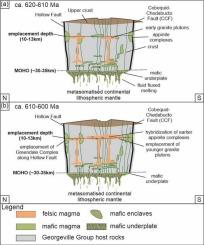格林代尔(斜长岩)杂岩的地幔水源:岩浆弧中花岗岩基的成因和地壳生长的意义
IF 2.5
2区 地球科学
Q2 GEOCHEMISTRY & GEOPHYSICS
引用次数: 0
摘要
磷灰岩杂岩体是小的(~ 1-5公里宽)富含角闪石,主要是由异常富水的基性岩浆结晶而成的基性岩体。新元古代的格林德尔杂岩就是这些杂岩的典型代表,它是一个小的岩体,位于约10-15公里的深度,沿着俯冲末期侵入的花岗岩类岩体的外围毗邻一条大断层。杂岩体角闪石的稳定同位素δD值为−61 ~−72‰,δ18O值为+ 3.7 ~ +7.0‰,表明辉锑矿岩浆中的水主要来源于地幔。这些数据表明,斜晶岩可能代表了含水玄武岩岩浆的等分,这些岩浆在进入更高的地壳水平之前从结晶性基性底板中分离出来。有些角闪石就地结晶;另一些则在~ 12-20公里深处结晶,从~ 950-870°C冷却,并随着岩浆上升而被带走。在基性底镀过程中,地幔流体和热量向下地壳的转移引发了部分熔融,并产生了同时期的花岗岩类岩浆。这些花岗岩类位于浅层(~ 3-5 kbar),形成了一个管道系统的上部,形成了流变障碍,除了沿着深地壳空心断层(该断层与深部成矿系统相结合,格林德尔杂岩就是沿着这条断层形成的),阻碍了同时期镁质岩浆的上升。更一般地说,这些关系暗示了活动断裂和超压含水基性岩浆侵位之间的反馈,促进了快速上升和高度过冷,以及含水饱和度特征的不平衡结构。阿扁岩浆岩可以提供一个直接的窗口,以了解结晶基性底板和深地壳热区的流体状况。因此,斜长岩复合体提供了对弧系中花岗岩基和地壳生长过程的深入了解。本文章由计算机程序翻译,如有差异,请以英文原文为准。

A mantle source for water in the Greendale (appinite) Complex: Implications for genesis of granitoid batholiths and crustal growth in magmatic arcs
Appinite complexes are small (∼1–5 km wide) hornblende-rich, predominantly mafic plutons that crystallized from anomalously water-rich mafic magma. The Neoproterozoic Greendale Complex, Nova Scotia, exemplifies these complexes, occurring as a small pluton, emplaced at ∼10–15 km depth, adjacent to a major fault along the periphery of granitoid plutons intruded in the waning stages of subduction. Stable isotopic data from hornblende in the complex yield −61 to −72 ‰ δD and + 3.7 to +7.0 ‰ δ18O values, indicating water in the appinite magma was dominantly mantle-derived. These data suggest appinites may represent aliquots of hydrous basaltic magma that segregated from a crystallizing mafic underplate before emplacement at higher crustal levels. Some amphiboles crystallized in situ; others crystallized at ∼12–20 km depth, cooled from ∼950-870 °C, and were entrained as the magma ascended.
Transfer of mantle-derived fluids and heat into the lower crust during mafic underplating triggered partial melting and generation of coeval granitoid magmas. These granitoids were emplaced at shallow levels (∼3–5 kbar) and formed the upper part of a plumbing system that created rheological barriers, impeding the ascent of coeval mafic magmas except along the deep crustal Hollow Fault, which bounded the plutonic system and along which the Greendale Complex was emplaced. More generally, these relationships imply feedback between active faulting and emplacement of overpressured hydrous mafic magmas, facilitating rapid ascent and high degrees of undercooling, and disequilibrium textures characteristic of water saturation. Appinite magmas may provide a direct window into the fluid conditions of the crystallizing mafic underplate and Deep Crustal Hot Zone. Therefore, appinite complexes provide deep insights into the processes that generate granitoid batholiths and crustal growth in arc systems.
求助全文
通过发布文献求助,成功后即可免费获取论文全文。
去求助
来源期刊

Lithos
地学-地球化学与地球物理
CiteScore
6.80
自引率
11.40%
发文量
286
审稿时长
3.5 months
期刊介绍:
Lithos publishes original research papers on the petrology, geochemistry and petrogenesis of igneous and metamorphic rocks. Papers on mineralogy/mineral physics related to petrology and petrogenetic problems are also welcomed.
 求助内容:
求助内容: 应助结果提醒方式:
应助结果提醒方式:


